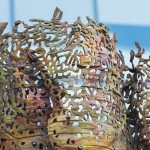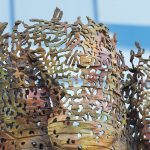“Oxytocin and social adaption”
Yina Ma, IDG/McGovern Institute, Beijing Normal University
November 8, 2016
Category: Uncategorized
A radiation-free approach to imaging molecules in the brain
Scientists hoping to get a glimpse of molecules that control brain activity have devised a new probe that allows them to image these molecules without using any chemical or radioactive labels.
Currently the gold standard approach to imaging molecules in the brain is to tag them with radioactive probes. However, these probes offer low resolution and they can’t easily be used to watch dynamic events, says Alan Jasanoff, an MIT professor of biological engineering.
Jasanoff and his colleagues have developed new sensors consisting of proteins designed to detect a particular target, which causes them to dilate blood vessels in the immediate area. This produces a change in blood flow that can be imaged with magnetic resonance imaging (MRI) or other imaging techniques.
“This is an idea that enables us to detect molecules that are in the brain at biologically low levels, and to do that with these imaging agents or contrast agents that can ultimately be used in humans,” Jasanoff says. “We can also turn them on and off, and that’s really key to trying to detect dynamic processes in the brain.”
In a paper appearing in the Dec. 2 issue of Nature Communications, Jasanoff and his colleagues used these probes to detect enzymes called proteases, but their ultimate goal is to use them to monitor the activity of neurotransmitters, which act as chemical messengers between brain cells.
The paper’s lead authors are postdoc Mitul Desai and former MIT graduate student Adrian Slusarczyk. Recent MIT graduate Ashley Chapin and postdoc Mariya Barch are also authors of the paper.
Indirect imaging
To make their probes, the researchers modified a naturally occurring peptide called calcitonin gene-related peptide (CGRP), which is active primarily during migraines or inflammation. The researchers engineered the peptides so that they are trapped within a protein cage that keeps them from interacting with blood vessels. When the peptides encounter proteases in the brain, the proteases cut the cages open and the CGRP causes nearby blood vessels to dilate. Imaging this dilation with MRI allows the researchers to determine where the proteases were detected.
“These are molecules that aren’t visualized directly, but instead produce changes in the body that can then be visualized very effectively by imaging,” Jasanoff says.
Proteases are sometimes used as biomarkers to diagnose diseases such as cancer and Alzheimer’s disease. However, Jasanoff’s lab used them in this study mainly to demonstrate the validity their approach. Now, they are working on adapting these imaging agents to monitor neurotransmitters, such as dopamine and serotonin, that are critical to cognition and processing emotions.
To do that, the researchers plan to modify the cages surrounding the CGRP so that they can be removed by interaction with a particular neurotransmitter.
“What we want to be able to do is detect levels of neurotransmitter that are 100-fold lower than what we’ve seen so far. We also want to be able to use far less of these molecular imaging agents in organisms. That’s one of the key hurdles to trying to bring this approach into people,” Jasanoff says.
Jeff Bulte, a professor of radiology and radiological science at the Johns Hopkins School of Medicine, described the technique as “original and innovative,” while adding that its safety and long-term physiological effects will require more study.
“It’s interesting that they have designed a reporter without using any kind of metal probe or contrast agent,” says Bulte, who was not involved in the research. “An MRI reporter that works really well is the holy grail in the field of molecular and cellular imaging.”
Tracking genes
Another possible application for this type of imaging is to engineer cells so that the gene for CGRP is turned on at the same time that a gene of interest is turned on. That way, scientists could use the CGRP-induced changes in blood flow to track which cells are expressing the target gene, which could help them determine the roles of those cells and genes in different behaviors. Jasanoff’s team demonstrated the feasibility of this approach by showing that implanted cells expressing CGRP could be recognized by imaging.
“Many behaviors involve turning on genes, and you could use this kind of approach to measure where and when the genes are turned on in different parts of the brain,” Jasanoff says.
His lab is also working on ways to deliver the peptides without injecting them, which would require finding a way to get them to pass through the blood-brain barrier. This barrier separates the brain from circulating blood and prevents large molecules from entering the brain.
The research was funded by the National Institutes of Health BRAIN Initiative, the MIT Simons Center for the Social Brain, and fellowships from the Boehringer Ingelheim Fonds and the Friends of the McGovern Institute.
Researchers create synthetic cells to isolate genetic circuits
Synthetic biology allows scientists to design genetic circuits that can be placed in cells, giving them new functions such as producing drugs or other useful molecules. However, as these circuits become more complex, the genetic components can interfere with each other, making it difficult to achieve more complicated functions.
MIT researchers have now demonstrated that these circuits can be isolated within individual synthetic “cells,” preventing them from disrupting each other. The researchers can also control communication between these cells, allowing for circuits or their products to be combined at specific times.
“It’s a way of having the power of multicomponent genetic cascades, along with the ability to build walls between them so they won’t have cross-talk. They won’t interfere with each other in the way they would if they were all put into a single cell or into a beaker,” says Edward Boyden, an associate professor of biological engineering and brain and cognitive sciences at MIT. Boyden is also a member of MIT’s Media Lab and McGovern Institute for Brain Research, and an HHMI-Simons Faculty Scholar.
This approach could allow researchers to design circuits that manufacture complex products or act as sensors that respond to changes in their environment, among other applications.
Boyden is the senior author of a paper describing this technique in the Nov. 14 issue of Nature Chemistry. The paper’s lead authors are former MIT postdoc Kate Adamala, who is now an assistant professor at the University of Minnesota, and former MIT grad student Daniel Martin-Alarcon. Katriona Guthrie-Honea, a former MIT research assistant, is also an author of the paper.
Circuit control
The MIT team encapsulated their genetic circuits in droplets known as liposomes, which have a fatty membrane similar to cell membranes. These synthetic cells are not alive but are equipped with much of the cellular machinery necessary to read DNA and manufacture proteins.
By segregating circuits within their own liposomes, the researchers are able to create separate circuit subroutines that could not run in the same container at the same time, but can run in parallel to each other, communicating in controlled ways. This approach also allows scientists to repurpose the same genetic tools, including genes and transcription factors (proteins that turn genes on or off), to do different tasks within a network.
“If you separate circuits into two different liposomes, you could have one tool doing one job in one liposome, and the same tool doing a different job in the other liposome,” Martin-Alarcon says. “It expands the number of things that you can do with the same building blocks.”
This approach also enables communication between circuits from different types of organisms, such as bacteria and mammals.
As a demonstration, the researchers created a circuit that uses bacterial genetic parts to respond to a molecule known as theophylline, a drug similar to caffeine. When this molecule is present, it triggers another molecule known as doxycycline to leave the liposome and enter another set of liposomes containing a mammalian genetic circuit. In those liposomes, doxycycline activates a genetic cascade that produces luciferase, a protein that generates light.
Using a modified version of this approach, scientists could create circuits that work together to produce biological therapeutics such as antibodies, after sensing a particular molecule emitted by a brain cell or other cell.
“If you think of the bacterial circuit as encoding a computer program, and the mammalian circuit is encoding the factory, you could combine the computer code of the bacterial circuit and the factory of the mammalian circuit into a unique hybrid system,” Boyden says.
The researchers also designed liposomes that can fuse with each other in a controlled way. To do that, they programmed the cells with proteins called SNAREs, which insert themselves into the cell membrane. There, they bind to corresponding SNAREs found on surfaces of other liposomes, causing the synthetic cells to fuse. The timing of this fusion can be controlled to bring together liposomes that produce different molecules. When the cells fuse, these molecules are combined to generate a final product.
More modularity
The researchers believe this approach could be used for nearly any application that synthetic biologists are already working on. It could also allow scientists to pursue potentially useful applications that have been tried before but abandoned because the genetic circuits interfered with each other too much.
“The way that we wrote this paper was not oriented toward just one application,” Boyden says. “The basic question is: Can you make these circuits more modular? If you have everything mishmashed together in the cell, but you find out that the circuits are incompatible or toxic, then putting walls between those reactions and giving them the ability to communicate with each other could be very useful.”
Vincent Noireaux, an associate professor of physics at the University of Minnesota, described the MIT approach as “a rather novel method to learn how biological systems work.”
“Using cell-free expression has several advantages: Technically the work is reduced to cloning (nowadays fast and easy), we can link information processing to biological function like living cells do, and we work in isolation with no other gene expression occurring in the background,” says Noireaux, who was not involved in the research.
Another possible application for this approach is to help scientists explore how the earliest cells may have evolved billions of years ago. By engineering simple circuits into liposomes, researchers could study how cells might have evolved the ability to sense their environment, respond to stimuli, and reproduce.
“This system can be used to model the behavior and properties of the earliest organisms on Earth, as well as help establish the physical boundaries of Earth-type life for the search of life elsewhere in the solar system and beyond,” Adamala says.
Artist Lecture: Ursula von Rydingsvard
On October 28, 2016, the McGovern Institute held a dedication ceremony for SCIENTIA, a monumental bronze sculpture located at the entrance to the McGovern Institute at 550 Main Street in Cambridge, MA. SCIENTIA, by Ursula von Rydingsvard, is a gift from Lore Harp McGovern and represents the 52nd piece of public art on the MIT campus. In this video, von Rydingsvard explains the creative process involved in making SCIENTIA.
Stanley Center and Poitras Center Joint Translational Neuroscience Seminar: John Gabrieli
October 11, 2016
Stanley Center and Poitras Center Joint Translational Neuroscience Seminar Series
Speaker: John Gabrieli, McGovern Institute for Brain Research at MIT
Title: Predictive Neuroimaging and Precision Medicine for Neuropsychiatric Treatments
SCIENTIA
The newest addition to MIT’s Public Art Collection is on permanent display at the entrance to the McGovern Institute for Brain Research. “SCIENTIA,” a monumental bronze sculpture by Ursula von Rydingsvard is a gift from Lore Harp McGovern and represents the 52nd piece of public art on campus. The sculpture was dedicated in a public ceremony on Friday, Oct. 28 at 5 p.m., followed by an artist talk. Photos of the sculpture and the dedication may be found below.
SCIENTIA
SCIENTIA, 2016 by Itinerant Pictures
Documentary video on the making of SCIENTIA, a sculpture by Ursula von Rydingsvard located at the entrance to MIT’s McGovern Institute. The monumental sculpture was commissioned by Lore Harp McGovern for the McGovern Institute for Brain Research and the public art collection of the Massachusetts Institute of Technology.
McGovern Institute 2016 Halloween Party
And the winner of this year’s costume contest (by popular vote) goes to Ruth Rosenholtz for her depiction of presidential candidate Donald Trump! See below for a full gallery of images from our annual Halloween party.
Monumental new sculpture commissioned for MIT’s McGovern Institute
The newest addition to MIT’s Public Art Collection is now on permanent display at the McGovern Institute for Brain Research at 550 Main Street in Kendall Square, Cambridge, Massachusetts. “SCIENTIA,” a monumental bronze sculpture by Ursula von Rydingsvard is a gift from Lore Harp McGovern and represents the 52nd piece of public art on campus. The new work will be dedicated in a public ceremony on Friday, Oct. 28 at 5 p.m., followed by a free artist talk at 6 p.m. in the Singleton Auditorium (Room 46-3002).
“’SCIENTIA’ represents that art and science are not separate entities,” says Lore Harp McGovern, co-founder of the McGovern Institute and a member of the Council for the Arts at MIT. “Art defines our humanity, advances our curiosity, and forces us to ask big questions — questions the McGovern Institute for Brain Research is trying to answer. ‘SCIENTIA’ invites you in.”
Von Rydingsvard’s “SCIENTIA” is among her most ambitious sculptures to date, at approximately 24 feet tall and over 17,000 pounds. In creating the work, the artist first produced a wood model in her studio using 4×4-inch cedar beams milled for the construction industry. Using circular saws and a range of cutting tools, she sliced, marked, and shaped the wood elements, then stacked them to create layers that were glued and screwed into place. The full-scale wood model was then transported to Polich Tallix Fine Art Foundry (founded by Richard Polich SM ’65), where the majority of the sculpture was sand cast while the delicate filigree sections were cast using the lost-wax technique. Von Rydingsvard patinated the bronze surface by hand with chemicals and a blow torch.
For over 30 years, von Rydingsvard has been making monumental sculptures that reveal the trace of the human hand and resemble objects and environments that echo the artist’s family heritage in pre-industrial Poland. The artist’s childhood was marked by the strain of living in eight different refugee camps over the course of five years. Her earliest recollections — of displacement and subsistence through humble means — infuse her work with emotional potency. Von Rydingsvard has built towering cedar structures, creating intricate networks of individual beams, shaped by sharp and lyrical cuts and fused together to form rich, dynamic surfaces. While abstract at its core, von Rydingsvard’s work takes visual cues from the landscape, the human body, and utilitarian objects — such as the artist’s collection of household vessels — and demonstrates an interest in the point where the human-made meets nature.
“Ursula von Rydingsvard’s commissioned piece for the McGovern is a fantastic addition to MIT’s great public art collection,” List Visual Arts Center Director Paul C. Ha says. “This powerful sculpture will inspire many and will be one of the signature pieces in our collection. We’re grateful for Ms. McGovern’s thoughtfulness and her generosity in helping us acquire this magnificent piece for MIT.”
A new player in appetite control
MIT neuroscientists have discovered that brain cells called glial cells play a critical role in controlling appetite and feeding behavior. In a study of mice, the researchers found that activating these cells stimulates overeating, and that when the cells are suppressed, appetite is also suppressed.
The findings could offer scientists a new target for developing drugs against obesity and other appetite-related disorders, the researchers say. The study is also the latest in recent years to implicate glial cells in important brain functions. Until about 10 years ago, glial cells were believed to play more of a supporting role for neurons.
“In the last few years, abnormal glial cell activities have been strongly implicated in neurodegenerative disorders. There is more and more evidence to point to the importance of glial cells in modulating neuronal function and in mediating brain disorders,” says Guoping Feng, the James W. and Patricia Poitras Professor of Neuroscience. Feng is also a member of MIT’s McGovern Institute for Brain Research and the Stanley Center for Psychiatric Research at the Broad Institute.
Feng is one of the senior authors of the study, which appears in the Oct. 18 edition of the journal eLife. The other senior author is Weiping Han, head of the Laboratory of Metabolic Medicine at the Singapore Bioimaging Consortium in Singapore. Naiyan Chen, a postdoc at the Singapore Bioimaging Consortium and the McGovern Institute, is the lead author.
Turning on appetite
It has long been known that the hypothalamus, an almond-sized structure located deep within the brain, controls appetite as well as energy expenditure, body temperature, and circadian rhythms including sleep cycles. While performing studies on glial cells in other parts of the brain, Chen noticed that the hypothalamus also appeared to have a lot of glial cell activity.
“I was very curious at that point what glial cells would be doing in the hypothalamus, since glial cells have been shown in other brain areas to have an influence on regulation of neuronal function,” she says.
Within the hypothalamus, scientists have identified two key groups of neurons that regulate appetite, known as AgRP neurons and POMC neurons. AgRP neurons stimulate feeding, while POMC neurons suppress appetite.
Until recently it has been difficult to study the role of glial cells in controlling appetite or any other brain function, because scientists haven’t developed many techniques for silencing or stimulating these cells, as they have for neurons. Glial cells, which make up about half of the cells in the brain, have many supporting roles, including cushioning neurons and helping them form connections with one another.
In this study, the research team used a new technique developed at the University of North Carolina to study a type of glial cell known as an astrocyte. Using this strategy, researchers can engineer specific cells to produce a surface receptor that binds to a chemical compound known as CNO, a derivative of clozapine. Then, when CNO is given, it activates the glial cells.
The MIT team found that turning on astrocyte activity with just a single dose of CNO had a significant effect on feeding behavior.
“When we gave the compound that specifically activated the receptors, we saw a robust increase in feeding,” Chen says. “Mice are not known to eat very much in the daytime, but when we gave drugs to these animals that express a particular receptor, they were eating a lot.”
The researchers also found that in the short term (three days), the mice did not gain extra weight, even though they were eating more.
“This raises the possibility that glial cells may also be modulating neurons that control energy expenditures, to compensate for the increased food intake,” Chen says. “They might have multiple neuronal partners and modulate multiple energy homeostasis functions all at the same time.”
When the researchers silenced activity in the astrocytes, they found that the mice ate less than normal.
Suzanne Dickson, a professor of neuroendocrinology at the University of Gothenburg in Sweden described the study as part of a “paradigm shift” toward the idea that glial cells have a less passive role than previously believed.
“We tend to think of glial cells as providing a support network for neuronal processes and that their activation is also important in certain forms of brain trauma or inflammation,” says Dickson, who was not involved in the research. “This study adds to the emerging evidence base that glial cells may also exert specific effects to control nerve cell function in normal physiology.”
Unknown interactions
Still unknown is how the astrocytes exert their effects on neurons. Some recent studies have suggested that glial cells can secrete chemical messengers such as glutamate and ATP; if so, these “gliotransmitters” could influence neuron activity.
Another hypothesis is that instead of secreting chemicals, astrocytes exert their effects by controlling the uptake of neurotransmitters from the space surrounding neurons, thereby affecting neuron activity indirectly.
Feng now plans to develop new research tools that could help scientists learn more about astrocyte-neuron interactions and how astrocytes contribute to modulation of appetite and feeding. He also hopes to learn more about whether there are different types of astrocytes that may contribute differently to feeding behavior, especially abnormal behavior.
“We really know very little about how astrocytes contribute to the modulation of appetite, eating, and metabolism,” he says. “In the future, dissecting out these functional difference will be critical for our understanding of these disorders.”
















































